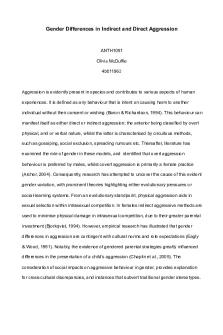Differences in communication essay PDF

| Title | Differences in communication essay |
|---|---|
| Course | Cultural and Social Diversity in Behavioral Health |
| Institution | Grand Canyon University |
| Pages | 4 |
| File Size | 62.3 KB |
| File Type | |
| Total Downloads | 111 |
| Total Views | 156 |
Summary
This was an essay regarding differences that exist in communication. It revolves around the way that different cultures communicate with one another and the importance of knowing this in the behavioral health field....
Description
Communication is an aspect of life that allows for us to form professional and social relationships amongst those in our community. It is built around many varying factors that include not only verbal but nonverbal communication as well. Qualified psychologist, Claire Newton, outlined the different communication styles that are present throughout any culture in her article titled “The Five Communication Styles”. The communication styles she discusses include “assertive, aggressive, passive-aggressive, submissive and manipulative” (Newton, 2011). Each of these communication strategies are expressed throughout each culture in their own way. Examples of these communication styles can be seen in the differences between the American and Hispanic culture. The culture in the United States is very diverse and distinct due to the decades of immigration from other countries throughout the years. This level of diversity has resulted in what is known as an individualistic culture. Individualism is “the notion that our behaviors and attitudes are guided by incentives that promote self-determination or independence” (Afs-Usa, 2019). The American culture places importance on what benefits them individually, rather than what could benefit the culture as a whole. The form of communication through American cultures may come off as being aggressive or very assertive to other cultures. They tend to convey their messages directly, failing to place focus on their body language. People are expected to be clear and get straight to the point, which does not mean that courtesy is disregarded in communication, but Americans’ sometimes miss nuances in conversation or types of humor, so they appreciate when someone is direct. Regarding nonverbal communication, Americans’ tend to smile when passing a stranger because it is a simple gesture of goodwill and it is highly encouraged in professional environments. It is also best to nod or show that you are listening throughout a conversation. This is also a positive attending skill that is highly
encouraged in order to show respect for a person and show interest in what they are saying. In American culture, strong eye contact is considered as a sign of strength and confidence and it is highly encouraged as early as from the time the individual is able to speak. Failure to avoid eye contact results in damage to professional relationships and failure towards reaching their full potential, according to cultural beliefs. In regard to physical space, most Americans value their personal space and feel discomfort, upset, or anxiety when another person gets too close. This is especially true when talking to or meeting a new person and when in groups. Overall, the American culture is very individualistic, and their form of communication is very specific in regard to that. On the contrary to that, the Hispanic culture tends to be more conservative and traditional in their lifestyle. They are assertive, but they tend to be closer and nurturing amongst one another. Hugging and kissing on the cheek is a very common practice seen amongst men and women, close friends or relatives, which is not common in American culture. When meeting someone new this is normally how Hispanics tend to greet each other. Hispanic cultures rely heavily on nonverbal facial expressions such as frowning or tipping the head. As in many cultures, Hispanics also communicate by smiling and nodding at one another to show approval. Verbal communication is courteous and respectful, as in any other culture. Direct eye contact is often viewed as disrespectful in this culture, opposite to American culture. When a person from a Hispanic culture is being spoken to, they tend to look away or down as a sign of respect to the person speaking, especially if that person is significantly older than the listener or is in a position of authority over them. Unlike American culture, personal space is approached differently. People of this culture prefer being closer to each other. If someone gives too much personal space, they are seen as being uninterested or detached. Hispanics value affection and close
proximity. Moreover, body language is important within the Hispanic culture. They use a lot of gestures and facial expressions in their conversations in order to represent what they are trying to communicate to someone. They are loud and outgoing, and they want their conversations to express that. Attending skills include being courteous and sympathetic because the Hispanic culture places emphasis on their nurturing manner, and it is appreciated to receive that type of treatment in reverse. To summarize, this culture appreciates receiving affection and their form of communication is unique in its own way. In conclusion, both cultures have their own way of communicating effectively between one another. There are numerous similarities and some variances within the ways that communication is shown. Neither methods of communication are frowned upon, as that is simply the way that people have outlined as being acceptable within their culture. For the most part, it is acceptable to smile and nod while individuals are speaking to you in order to show them respect. However, eye contact is something that can differ across these two cultures. It is important to be considerate of the differences in communication methods within cultures, especially in the behavioral health field in order to avoid disrespecting someone. We must find a way to understand how people from different cultures speak, communicate, and perceive the world around them in order to be a well-rounded individual that aspires to show respect to all cultures.
References 1. Newton, C. (2011). The Five Communication Styles. Retrieved from http://www.clairenewton.co.za/my-articles/the-five-communication-styles.html 2. Afs-Usa. (2019, November 5). Culture Points: Individualism & Collectivism - AFS-USA. Retrieved from https://www.afsusa.org/study-abroad/culture-trek/culturepoints/culture-points-individualism-and-collectivism/...
Similar Free PDFs

Gender Differences Essay
- 6 Pages

Gender differences in senses
- 11 Pages

Gender differences in crime
- 6 Pages

Business Communication Essay
- 9 Pages

Communication Essay Draft
- 4 Pages

GE Purposive Communication Essay
- 5 Pages

Communication Essay - Assignment
- 7 Pages

Effective Communication essay
- 9 Pages
Popular Institutions
- Tinajero National High School - Annex
- Politeknik Caltex Riau
- Yokohama City University
- SGT University
- University of Al-Qadisiyah
- Divine Word College of Vigan
- Techniek College Rotterdam
- Universidade de Santiago
- Universiti Teknologi MARA Cawangan Johor Kampus Pasir Gudang
- Poltekkes Kemenkes Yogyakarta
- Baguio City National High School
- Colegio san marcos
- preparatoria uno
- Centro de Bachillerato Tecnológico Industrial y de Servicios No. 107
- Dalian Maritime University
- Quang Trung Secondary School
- Colegio Tecnológico en Informática
- Corporación Regional de Educación Superior
- Grupo CEDVA
- Dar Al Uloom University
- Centro de Estudios Preuniversitarios de la Universidad Nacional de Ingeniería
- 上智大学
- Aakash International School, Nuna Majara
- San Felipe Neri Catholic School
- Kang Chiao International School - New Taipei City
- Misamis Occidental National High School
- Institución Educativa Escuela Normal Juan Ladrilleros
- Kolehiyo ng Pantukan
- Batanes State College
- Instituto Continental
- Sekolah Menengah Kejuruan Kesehatan Kaltara (Tarakan)
- Colegio de La Inmaculada Concepcion - Cebu







